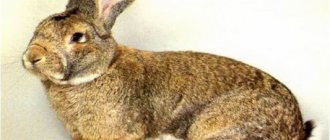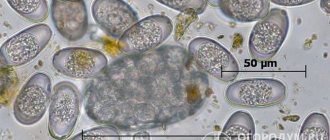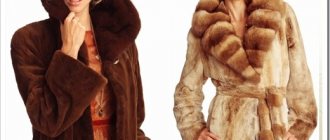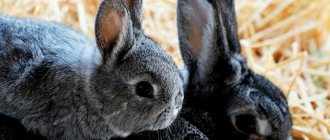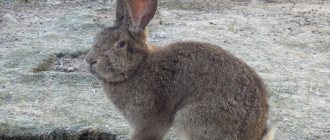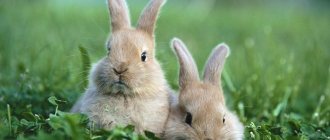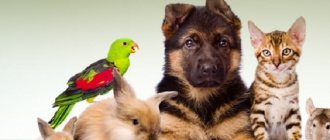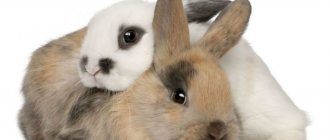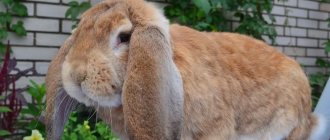Expert opinion
Dobryshev Sergey Anatolievich
Professional rabbit breeder and hare breeder with 30 years of experience
In order to better understand the worldview of your long-eared pets, you need to understand how rabbits see. The structure of the visual organs of rabbits differs from that of their owners, therefore they see their surroundings somewhat differently. This is necessary to know in order to successfully care for them.
Difference from man
In humans, the eyes are located at the front of the head. This arrangement was formed during evolution. Primates obtained food using their hands. In order to see future food and, for example, pick it, it was necessary to be able to examine it itself and the place where it is located, both near and at a distance.
Wild rabbits had a different task. The main thing for them was the opportunity to dodge numerous predators, for whom they themselves could become tasty food. If they had to turn around to look at their surroundings from the side and behind, then precious seconds would be lost.
The location of rabbits' visual organs on both sides of the head provides them with an almost 360-degree view. Rodents are especially good at distinguishing objects located in the distance.
How does rabbit vision work?
Some rabbit owners, observing their charges, suspect that they have vision problems. It seems to them that the animal does not recognize its owner or does not see objects located directly in front of its muzzle. The thing is that the eyes of these animals are structured differently than those of people: they perceive the world completely differently. How rabbits see and whether they distinguish colors will be discussed in this article.
Structure of the eye
The eye structure of long-eared animals is not particularly different from other animals. Rabbits' eyes are large, convex, and ball-shaped. The eyeball located in the orbit is connected to the brain via the optic nerve.
Features include the presence of a third eyelid located in the inner corner of the eye. Its function is to protect the lacrimal glands.
How do rabbits see?
Rabbits are born blind. Their eyes open only when they reach 10–14 days of age. The rabbit has monocular vision. This means that the animal examines objects that fall into its field of vision with one eye.
Monocular vision is measured in angles. The long-eared one is able to inspect the area around itself at 360°. The field of view of the right and left eyes is layered anteriorly by 27° and posteriorly by 9°. Since this rodent's eyes are located on the sides, it can see a lot around, but, alas, it is not able to see what is in front of its nose.
If the crawler is looking forward, then the area in front is for it the so-called “blind zone”. Therefore, in order to examine objects that are in this zone, the rabbit needs to turn its head.
This structure of the visual apparatus in rabbits is adapted for self-preservation. An animal can notice an approaching enemy from a distance and in a wide radius and manage to escape from it in time.
It is generally accepted that rabbits have color vision. This, in particular, is evidenced by studies conducted in the 70s of the last century, during which it was proven that rodents distinguish between 2 colors - blue and green. However, some researchers believe that this is not so, arguing that in these animals it is possible to achieve differentiation of certain colors using the method of conditioned reflexes.
Flaws
Rabbit vision, despite all the advantages, also has some disadvantages:
- Presence of a blind spot. Animals are able to see everything that is on the side and behind them, but they are deprived of the opportunity to see what is located directly in front of them.
- Lack of clarity of what is seen. Even in good lighting, pictures will be slightly blurry.
Even if you put his favorite treat - a carrot - in front of a rabbit, he will feel it rather than see it. A rabbit can also recognize objects in front of it using its sense of touch – its antennae. In order to see them, you have to turn sideways. With this movement, you should not think that your pet has vision problems.
Expert opinion
Dobryshev Sergey Anatolievich
Professional rabbit breeder and hare breeder with 30 years of experience
Important! Blurry images can cause the rabbit to not recognize its owner and hide in the corner of the cage.
Color perception
It seems completely natural for a person to look at the world in all its colors. The world is filled with a wide variety of shades of blue, red, green. But it’s not like that for our students. For many years, experts believed that the rabbit sees the world like a black and white movie. There are only shades of gray. But scientists were able to determine that this was not the case. It has been proven that the long-eared eye is able to distinguish between green and blue colors. Accordingly, all their shades and intersections. This is not such a rich world as a person’s, but also not as poor as a solid gray one. However, the question remains open of how animals perceive these colors. Today it is difficult to talk about this.
Another feature of rabbits’ vision can be considered that they practically do not close their eyes during sleep. It is difficult to say whether the video signal is being processed at this time or not, but they sleep very lightly. The slightest movement nearby and the animal wakes up.
From what has been said, it is clear: in order to understand how our pets perceive the world, we need to get acquainted with the characteristics of their senses. This will undoubtedly help you better manage your pets' behavior. Makes communication with them more interesting.
What colors do rabbits see?
The human visual organs are designed in such a way that they are able to perceive the world around us in all its abundance of colors. Thanks to the cones and rods that are found in the eyeballs, people distinguish between three primary colors:
- red;
- green;
- blue.
People distinguish three primary colors, but rabbits only two
Unlike people, long-eared pets have a more primitive visual apparatus; they are able to distinguish only two colors - blue and green.
Nature made sure that rabbits could recognize the approach of danger in time and hide from it. Their organs of vision differ from human ones in their structure and location, but they cannot be considered imperfect. The visual apparatus of eared animals operates in conjunction with other senses - touch, smell and hearing, which allows animals to navigate well in space even in the dark.
Read also: All about Saanen goats
Vision in the dark
Another important feature is how rabbits see in the dark. For an animal there is practically no difference between day and night. His vision works equally well. True, it is believed that a rabbit’s worldview is not as clear as that of a human. Perhaps his vision of the world is like a blurry picture. As soon as the owner picks up a large box, the animal will be confused. The owner's voice and smell are familiar, but the picture is different. When communicating with a pet, this should be taken into account, especially at the adaptation stage. The rabbit is a rather fearful animal.
Read also: DIY rabbit shed
Of course, rabbits feel absolutely comfortable in the dark. The main time of activity occurs during twilight and the time before sunrise. But we must not forget that rabbits need daylight. Light greatly affects the productivity and growth rate of babies.
Selecting a rabbit for breeding purposes (rabbit breeding)
According to zoological classification, the wild rabbit belongs to the class of mammals, the order of lagomorphs, the family of hares, and the genus of rabbits. Until recently, rabbits were classified as rodents due to their great similarity to these animals.
Constitution and exterior of rabbits
Head. Males usually have a wider head, more rounded and deeper than that of females, whose head is somewhat elongated, lighter and more delicate. In normally developed rabbits, the head is proportional to the body. A heavy and coarse head or too light and tender, with thin skin showing through on the ears, indicates in the first case a rough constitutional type, and in the second - a pampered one.
Read also: How and what to feed a cow in winter
eyes come in different colors: red (albinos), blue, brown, gray, black, etc. Each eye color has different shades.
The neck of normally developed rabbits is muscular and proportional to their body.
The body shape of rabbits varies depending on the breed: cylindrical (chinchilla), stocky (Viennese blue), approaching a wide rectangle (silver). In downy breeds, the body resembles a ball. The bones, whatever their shape, must be strong.
The chest of rabbits of all breeds should be wide and deep; such breasts are a sign of normal health and a strong constitution. Narrow and shallow breasts are a serious defect. The chest cavity contains the respiratory and circulatory organs, so the wider and deeper it is, the better developed the lungs and heart are. Narrow-chested rabbits are easily susceptible to disease, are less hardy and not so beautiful.
Large breed rabbits have a dewlap It reaches especially great development in females. However, its too strong development is undesirable.
The back and lower back should be wide and level. A humpbacked back is a defect in the exterior. A sagging back and narrow lower back indicate improper development and poverty of muscles, and weak bones. The sagging of the back and lower back in pregnant females should not be confused with these disadvantages.
The croup and rump of well-developed rabbits can have different shapes, depending on the breed. The chinchilla and silver have a rounded croup, the black-brown, veil-silver, white giant, Angora downy have a wide and rounded croup, the gray giant has a wide and bony croup. Females' croup should be wide and even. With this form of croup, they give birth easier and better. A chopped or drooping croup is a conformation defect
The belly of rabbits should be voluminous and elastic. A saggy belly is an exterior defect, which indicates improper feeding during the period of growth and development of the body.
The udder and mammary glands should be normally developed. Multiple and high-milk rabbits have more than four pairs of normally developed mammary glands. In lactating females, the nipples reach a length of 0.8-1.5 cm, with a normal length of about 0.5 cm. Poorly developed mammary glands secrete less milk, which affects the development of the young.
The skin characterizes the constitutional type of the animal. Loose skin is one of the signs of a raw constitution, very rough skin is one of the signs of a rough constitution. In strong and healthy rabbits it is strong, elastic and dense. Males usually have rougher and thicker skin than females.
the claws usually matches the color of the hair coat characteristic of this breed.
The hair of rabbits should be thick, soft and kneadable. The shine of the hair is a sign of the good health and nutrition of the animal, the strength of its constitution. Coarse hair with a lot of hair in it and too soft or sparse are undesirable.
The hair color The hair color of adult rabbits and young animals is determined by eye in diffuse daylight.
The live weight of rabbits is determined in a state of average fatness by weighing (before feeding) on a scale with an accuracy of 10 g. By the live weight of adult animals, one can judge their meat productivity and size. The live weight of the young shows how the individuals grow and develop.
Rabbits are examined and the length of the body and the volume of the chest behind the shoulder blades are measured. When assessing a rabbit, first of all you need to pay attention to the exterior as a whole, and then carefully evaluate all parts of the body. Such a comprehensive assessment will allow you to better select an animal with the necessary qualities.
Read also: Musk ox: what it looks like, where it is found, what it eats
